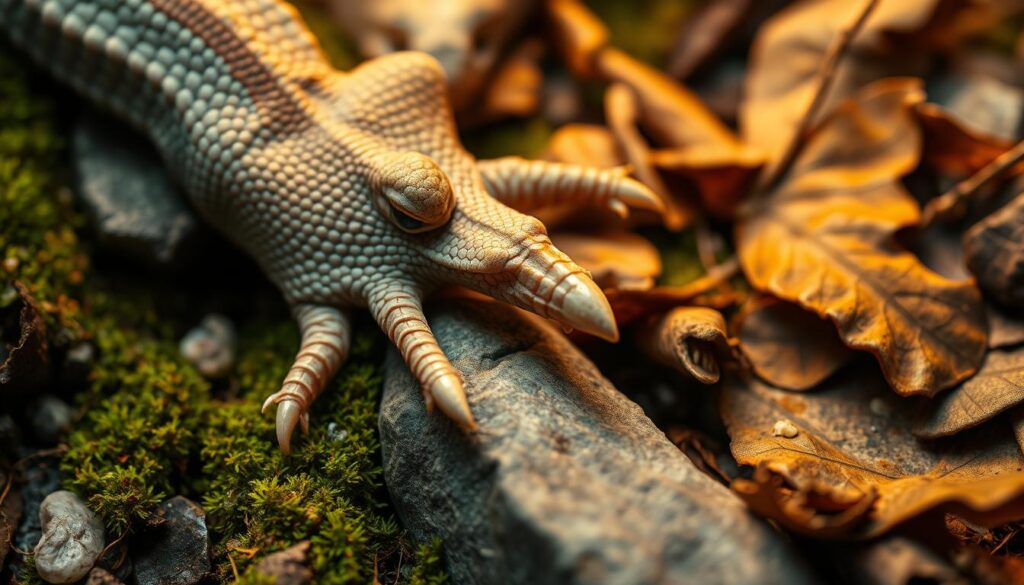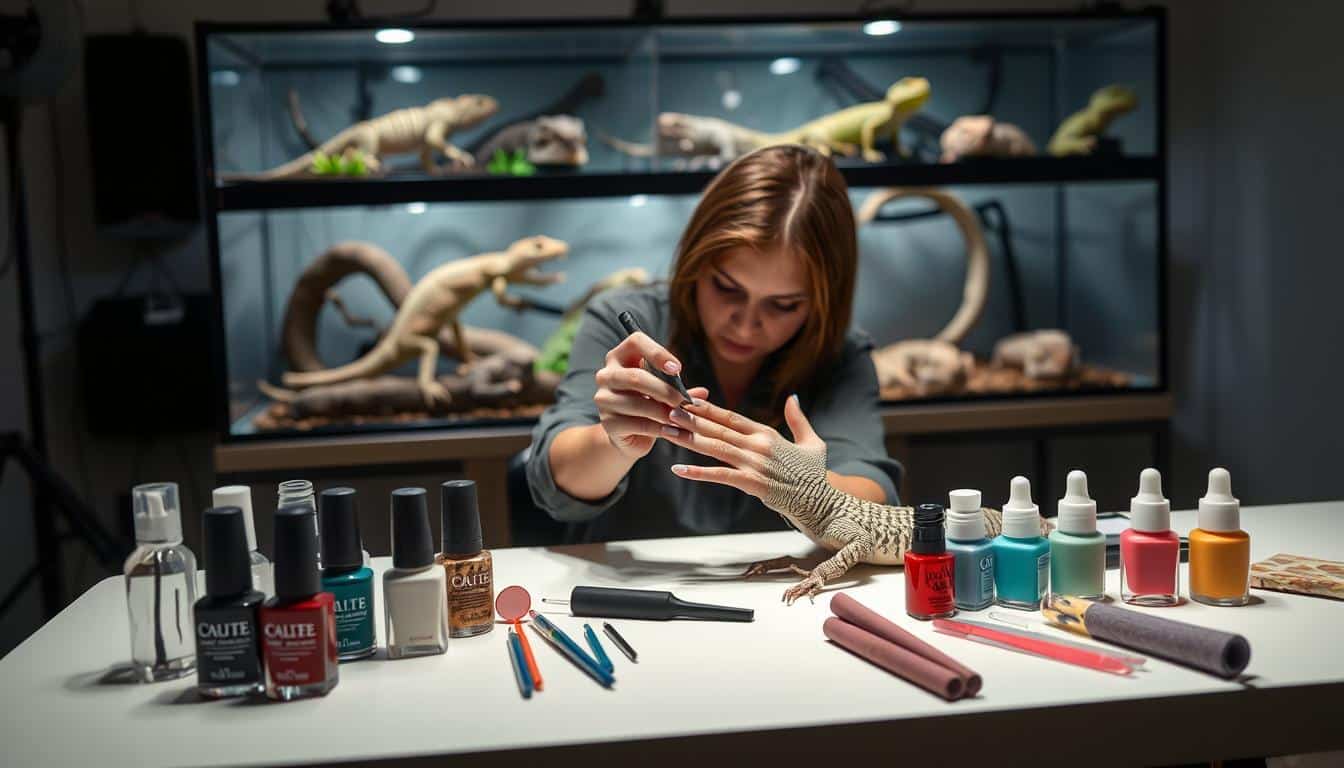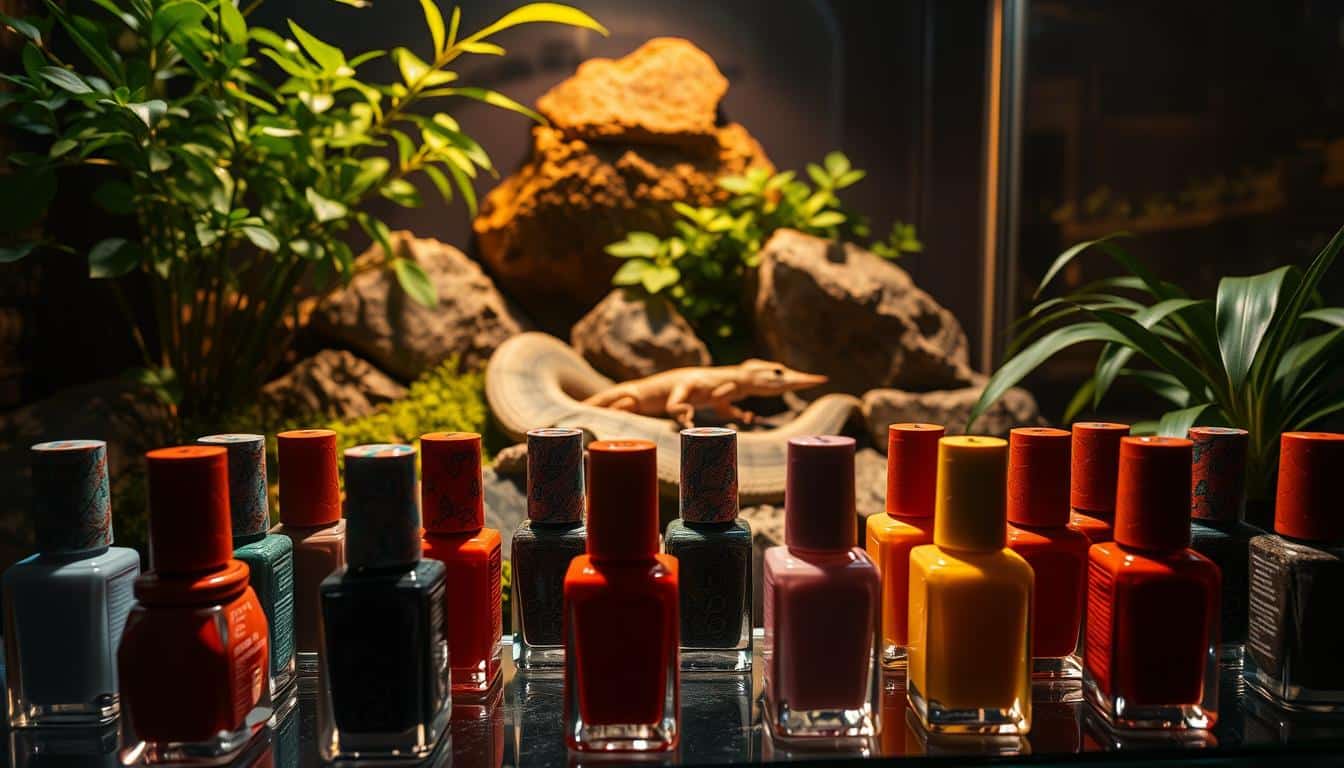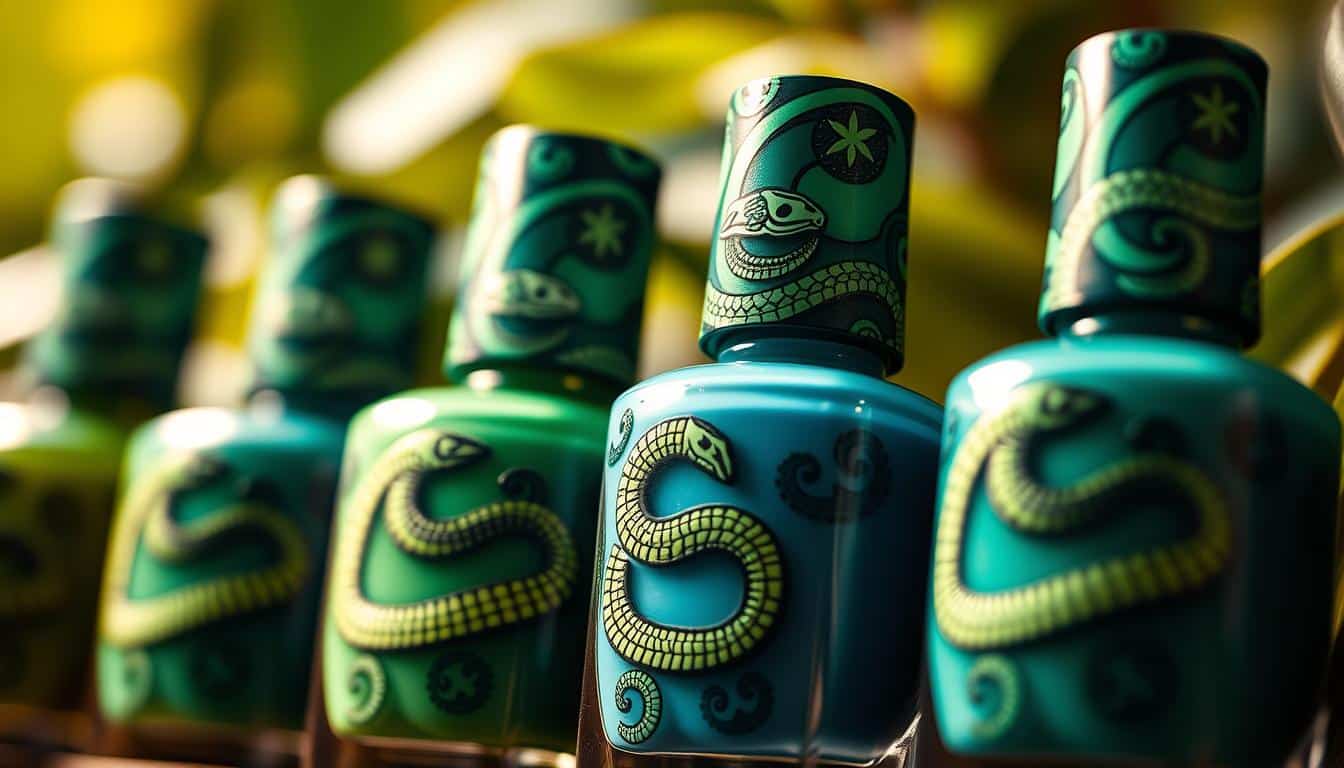Anúncios
Having a pet reptile is becoming more popular. So, knowing how to take care of their nails is key. Healthy nails are not just good for the reptiles, but they also keep pet owners safe. Keeping their nails trim is part of good lizard care. It helps avoid injuries and makes life better for your pets.
This article gives useful advice on keeping reptile nails healthy. It also shows why grooming is important for a safe and cozy home for your reptiles. By paying attention to nail care, reptile owners can help their pets live well in their homes.
The Importance of Nail Care for Reptiles
Reptile nail care is very important. Overgrown or sharp claws can hurt the reptile and the owner. They can scratch and cause discomfort. So, it’s key to keep their claws in good shape. In nature, lizards keep their nails short by being active. But in cages, they can’t do this much. So, owners must trim their lizard’s nails often.
Nail care is crucial for a reptile’s safety. If not trimmed, nails can catch on things or cause the reptile to lose balance. This might lead to injuries. Plus, taking care of their nails regularly makes handling them easier. This helps owners get closer to their pets. By keeping up with nail trimming, owners make a safer place for reptiles and improve their own experience too.

Understanding Natural Nail Wear in the Wild
In their natural habitats, reptiles undergo a specific process that helps maintain their nails. They navigate through various terrains. This journey helps keep their nails in great shape.
How Wild Habitats Contribute to Nail Maintenance
In nature, reptiles do many things like run, climb, and dig. Their claws touch rough surfaces like stones and sand. This helps wear down their nails naturally.
Thanks to their environment, their nails don’t overgrow. This is crucial for their survival and everyday activities.
Differences between Wild and Captive Environments
In captivity, the environment is different from the wild. Rough surfaces that help with nail care are often missing. This means captive reptiles can end up with nails that are too long.
This can lead to discomfort and health problems. Creating captive environments that are similar to the wild can really help.
Tips for Maintaining Healthy Nails in a Reptile Environment
To keep reptile nails healthy, it’s key to offer lots of fun activities. Use textured surfaces to help with natural nail care. Adding rough rocks or slate lets reptiles climb and sunbathe, helping trim their nails.
Checking nail length often is very important for lizard well-being. Set up a regular time for nail care, thinking about the ground they walk on and how active they are. Using these nail care tips will help your pet lizard live a better life.
Choosing the Right Substrate for Your Reptile
Picking the right bedding for your reptile is crucial for healthy nails. A good choice helps with natural nail wear, keeping your pet in top shape. It’s important to know the various substrate types and how they affect nail health for the best home setup.
Types of Substrates that Promote Natural Nail Wear
Some rough beddings help file down your reptile’s nails just right. Good options include:
- Packed sand
- Flagstone
- Gravel or crushed walnut shells
Choosing a substrate that mirrors a reptile’s wild environment helps keep nails trim. It prevents nail overgrowth. Pick one that fits your pet’s natural living conditions for their well-being.
What to Avoid for Nail Health
However, not all substrates are good for nail maintenance. Soft materials like:
- Paper towels
- Repticarpet
These might not wear down nails as needed, leading to overgrowth. Always choose substrates that match your pet’s normal activities and home. Doing so supports a healthy and active lifestyle for your reptile.
The Role of Activity Levels in Nail Care
It’s key to know how reptile activity and nail care link, for your pet’s wellness. Reptiles that move a lot naturally keep their nails short. They rub their nails against surfaces, which lowers trimming needs. But, less active reptiles might need more nail care.
How Frequent Movement Affects Nail Length
Being active really helps with nail health. Reptiles that move a lot usually have shorter nails. They wear them down by climbing, digging, and exploring. Setting up their home with different textures can help even more. On the other hand, reptiles that stay still often may get longer nails, needing regular nail checks.
- Monitor your reptile’s activity to determine appropriate trimming intervals.
- Encourage play and exploration to promote natural nail care.
- Assess the need for nail maintenance based on observed behavior.
Keep an eye on how active your reptile is to maintain healthy nails. This way, you ensure a happier, healthier pet.
Understanding When Nail Trimming is Necessary
Keeping up with reptile foot care means checking your reptile’s nails often. It’s crucial to see how well your lizard moves and the state of its nails to know when it’s time to trim.
Watch for clear signs for nail trimming. Nails that curl or catch on things mean a trim is needed. If your reptile struggles to walk or climb, its nails may be too long.
Regular checks improve your reptile’s life quality. Always make sure to trim nails on time for better health and movement.
Best Tools for Trimming Reptile Nails
Having the right tools makes nail trimming in reptiles easier. Lizards of different sizes need different methods and tools. Knowing what tools are out there can make grooming better for you and your pet.
Different Clipping Tools for Different Sizes of Lizards
When choosing clippers for reptiles, the size of the lizard is key. Small lizards can be trimmed with human nail clippers. But, bigger lizards need special pet clippers.
These tools give you more control and reduce injury risks. For very big reptiles, a Dremel tool can trim nails safely and efficiently without crushing them.
DIY vs. Professional Grooming
Choosing between DIY grooming and professional help depends on how comfortable and skilled you are. DIY saves money and lets you do maintenance more often. But, it requires patience and knowing how to avoid hurting the reptile.
Professional services offer expert care and special equipment. This reduces stress for both the reptile and the owner. Keeping your pet’s needs in mind will help you decide, ensuring their nails stay healthy.
Technique for Safely Clipping Your Lizard’s Nails
Clipping your lizard’s nails safely makes the process smooth for you and your pet. Learning the correct steps helps avoid injuring your lizard and keeps their nails healthy. By following a clear guide and practicing safely, you’ll make grooming time positive.
Step-by-Step Guide to Nail Clipping
- Prepare your workspace with proper lighting and all necessary tools at hand, including sharp, sanitized clippers specifically designed for lizards.
- Have an assistant if possible. They can gently hold the lizard wrapped in a towel, leaving only the feet exposed to minimize movement during the process.
- Carefully examine each nail to locate the quick, which is the sensitive area containing blood vessels. Ensure that only the nail tip is clipped to avoid injury.
- Proceed to clip just the tip of the nail without cutting into the quick. Trim slowly and with precision, checking for any signs of discomfort.
- After trimming, check the nails once again to ensure they are at an appropriate length. Offer a small treat as a reward for good behavior.
Tips for Reducing Stress on Your Reptile
- Perform nail trimming in a calm environment to reduce anxiety for your lizard.
- Use treats to distract your lizard and create a positive association with the grooming process.
- Take breaks if your lizard becomes agitated, allowing them to relax before continuing the clipping.
- Maintain a regular schedule for nail trimming to limit overgrowth and make each session shorter and more manageable.
Alternative Nail Care Methods: Filing and Grinding
For reptiles, keeping their nails healthy is essential. Some pet owners find traditional clipping isn’t the best choice. Nail filing is a softer option that works well in many cases. It allows for careful trimming, which reduces stress or pain for the reptile. For smaller, calm reptiles, filing is a good way to keep their claws in shape without causing them discomfort.
It’s important for pet owners to know when filing is better than clipping. This is especially true if the reptile gets nervous, or if using scissors or clippers feels risky. When filing, use a special reptile nail file to gently smooth edges. This avoids injuries. Although it takes time, this method is safe and effective.
- Filing can help prevent nail splitting or breaking.
- It offers a lower risk of cutting too close to the quick.
- This method is ideal for less active or anxious reptiles.
Adding nail filing for reptiles to your care practices is a secure, efficient way to keep their nails healthy. Trying out these alternatives can help your pet stay comfy and their nails in top condition.
Recognizing Nail Problems and Injury Prevention
It’s crucial to check your reptile’s nails often. This keeps their nails healthy and stops issues before they start. By keeping an eye out, you can catch nail problems early on.
Signs of Overgrown Nails and Potential Injury
There are clear signs your reptile might have nail issues. These signs include:
- Curling of the nail away from the toe
- Splitting or cracking
- Snagging on surfaces or items within the habitat
Ignoring these signs can cause serious injuries. This affects how they move and their happiness.
Preventative Measures to Take
To avoid nail injuries, there are steps you can take:
- Regularly check your reptile’s nails for signs of overgrowth.
- Maintain a suitable habitat surface that aids natural nail wear.
- Encourage activity through enrichment to prevent nail issues.
With these steps, you can keep your reptile healthy and comfy. This also lowers the risk of nail problems.
Conclusion
Taking care of reptile nails is key for their health and happiness. Knowing how to groom them right is part of this care. By using the right substrate and keeping them active, pet owners can make their habitats even better.
Always check the nails for any problems to keep them in good shape. Being ready to groom them is part of being a good pet owner. If you’re unsure, get help from someone who knows about reptiles and their needs.
By focusing on nail care, owners are doing a lot to make their reptiles’ lives better. Grooming is so important for their overall well-being. It helps them lead a joyful and healthy life.



